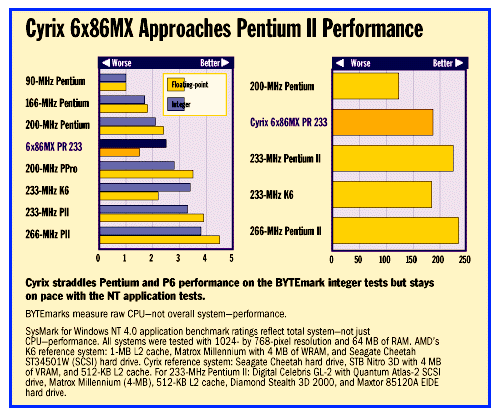| It's turning into a hot summer for x86 processors.
Following closely behind Intel's 300-MHz Pentium II,
Intel's 233-MHz Pentium, and AMD's 233-MHz K6 are two more
chips: one from Cyrix, and an innovative entry from a
newcomer, Centaur Technology. Both chips offer MMX
compatibility and strong performance for low-to mid-range
desktop systems. The Cyrix 6x86MX (formerly the M2) supersedes the current 6x86 by adding MMX instructions, quadrupling the size of the on-board cache (now 64 KB), doubling the resources for branch prediction, supporting CPU-bus speeds as high as 83 MHz, and adding a special scratch-pad feature to boost MMX throughput. Initial shipments of Cyrix's new chip come in three speed grades: the PR233, PR200, and PR166. According to these Cyrix "performance ratings," they compare to a 233-MHz Pentium II, a 200-MHz Pentium/MMX, and a 166-MHz Pentium/MMX, respectively. (Note that Cyrix's comparisons to Intel processors vary according to the speed grade.) Actual clock speeds are 187.5, 166.5, and 150 MHz. The PR233 costs only $320, about half the price of a 233-MHz Pentium II. Business application benchmark tests that BYTE ran on a Cyrix reference PC indicate that a PR233-equipped system delivers slightly better performance than one with AMD's 233-MHz K6 processor, which also had a bigger L2 cache than the Cyrix reference system (see the chart). The PR233 PC's performance did not quite match that of a 233-MHz Pentium II PC, but PR233 systems are less expensive. Prices will vary, but vendors such as CyberMax (800-443-9868) say PR233-based PCs will sell for about $400 less than similarly equipped Pentium II PCs. The PR200 costs $240, and the price of the PR166 is $190. All three Cyrix chips target the sub-$1500 PC market. Centaur, a new subsidiary of Integrated Device Technology (IDT), raises the number of companies currently making Pentium-class processors to four. Centaur's new IDT-C6 chip will come in three speeds: 200, 180, and 150 MHz. At 200 MHz, it matches the performance of a Pentium-200 with MMX, according to Centaur's benchmarks. (Centaur did not make an IDT-C6 system available to BYTE in time for this article.) The architect behind the IDT-C6 is Glenn Henry, Centaur's president. Henry was a well-known RISC architect at IBM and Mips, and he also led research into emulating x86-on-RISC. By applying RISC principles to the x86, Henry has masterminded a remarkably efficient CPU. The IDT-C6 is about half the size of a Pentium, even though IDT fabricates the chip on a comparable 0.35-micron, four-layer-metal, CMOS process. Of its 5.4 million transistors, only 1.4 million are located in the logic circuits. The rest are in the 64 KB of on-board cache. And because the mobile version of the chip dissipates only 7.1 to 10.6 W at 150 to 200 MHz, Centaur is targeting it for notebooks as well as sub-$1500 desktop PCs. Centaur faces stiff competition, however. Intel introduced 200- and 233-MHz mobile Pentiums in May and a 0.35-micron, 233-MHz desktop Pentium with MMX ($594 in quantities of 1000) in June. Thanks to a new 0.25-micron process, Intel's new 200- and 233-MHz mobile Pentiums (code-named Tillamook), dissipate less than 8 W. Both of the new mobile Pentiums will appear later this year, while the new desktop CPU is available now. Another challenge for both Centaur and Cyrix is MMX compatibility. Neither company has a patent cross-licensing agreement with Intel, as AMD does. And each company is taking a different approach to MMX. For example, Cyrix uses the FPU's multipliers and adders to execute MMX instructions. Intel uses the integer units, while AMD and Centaur use dedicated MMX units. Cyrix's approach requires fewer transistors and executes some MMX instructions in fewer cycles, but Intel's CPUs can handle two MMX instructions at a time. To compensate, Cyrix added a scratch-pad feature that preserves MMX data when the CPU flushes its cache. This, plus the larger cache, could make the 6x86MX more efficient at manipulating large MMX data sets. Look for BYTE to test the 6x86MX's MX performance in a future issue. Centaur is still running validation tests on the CPU, which is scheduled to ship in the third quarter of this year and is still unpriced. However, the additional competition for Intel will almost certainly result in lower PC prices. New PC Processors at a Glance
 Cyrix 6x86MX Approaches Pentium II Performance Copyright 1994-1998 BYTE |